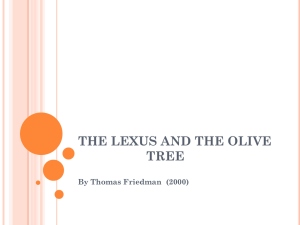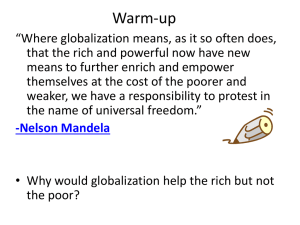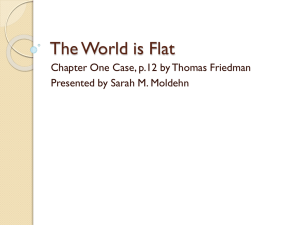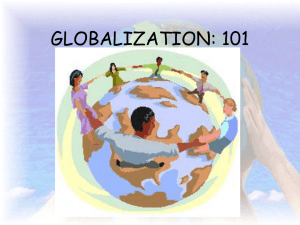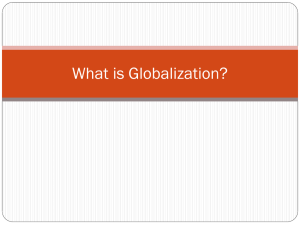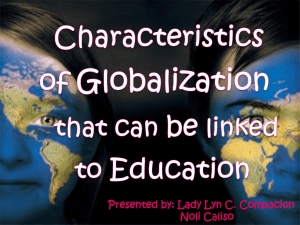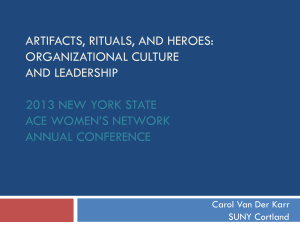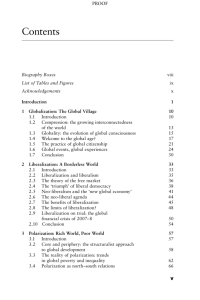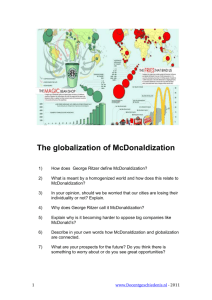Conceptions and Challenges of Globalization: Implications for
advertisement
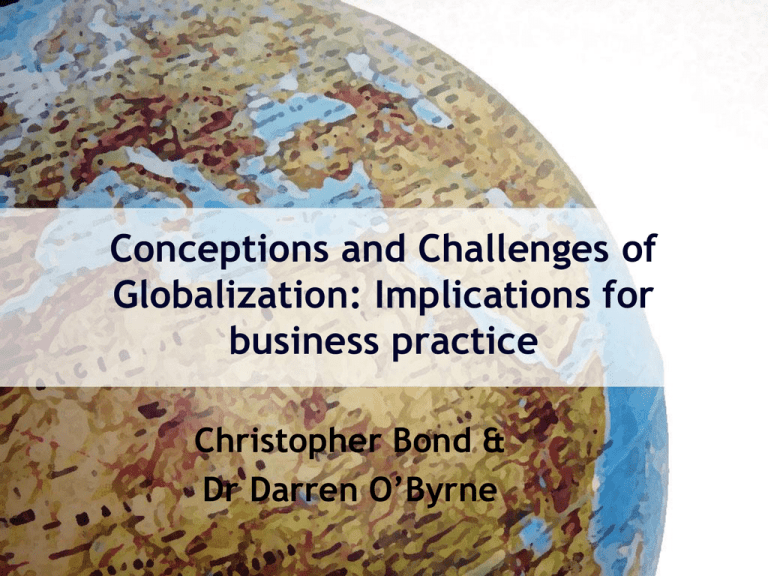
Conceptions and Challenges of Globalization: Implications for business practice Christopher Bond & Dr Darren O’Byrne Introduction • Conceptual paper building on O’Byrne and Hensby’s (2011) book Theorizing Global Studies. • Reviews 8 models of global change and assesses their potential impact on business practice and strategic choices. • Argues for the application of a multidimensional approach which highlights various forces at play in global transformation. Globalization • As a concept and in terms of effect more complex than extant business and management literature reflects. • Claims that current emphasis on unidisciplinary perspectives fails to appreciate true complexity of the multidisciplinary nature of business and the multifaceted challenges of Globalization. Our premise: “When commentators refer to ‘globalization’ they often do so without any clear, through interrogation into the actual dynamics of the process in question. ‘Globalization’ thus becomes a thing, the actual meaning of which is left uncontested.” Globalization as: • processes of economic integration: (Dixit and Norman, 1980; Ohmae, 1995a, 1995b; Wolf, 2004; Dicken, 2007;). • convergence of markets: (Roostal 1963; Levitt 1983; Jain 1989; Peebles 1989; Yip 1995; Solberg 2002; Johansson 2003). • applications of cross-cultural management practices: (Bartlett and Ghoshal 1987, 1998; Adler, 2001; Schneider and Barsoux, 2003; Steers, Nardon and Sanchez-Runde, 2010). • roles, relationships and effects of technology: (Cairncross, 1997 Castells, 1996, 2001; Friedman, 2000; Webster, 2005). • processes that impact on strategic choice: (Hout, Porter and Rudden, 1982; Hamel and Prahalad, 1985; Porter, 1986; Ghoshal, 1987; Yip, 1989, 1995). or globalization as: • Process(es) of global transformation which in the literal sense mean becoming global, rather than international or regional. • Views globalization as a complex mesh of overlapping processes, although presented as conceptual forms, reality of global change exists at the intersection of them all. Eight models of global change (O’Byrne & Hensby, 2011:202) Model Image of world society Globalization Orientation to ‘one world’ Liberalization Erosion of barriers between nation-states Polarization World divided into rich and poor Americanization American empire sustained through hard and soft power McDonaldization Standardization of practices across the world Creolization Ongoing local transformations through regional flows Transnationalization Emergence of level of governance above the nation-state Balkanization Division of world into distinct and conflicting cultural blocs Globalization is “the contemporary global condition can best be described as a complex social formation driven by forces which are at the same time globalizing, liberalizing, polarizing, Americanizing, McDonaldizing, creolizing, transnationalizing and balkanizing.” (O’Byrne, Hensby & Bond, 2011) Globalization • Convergence of economic markets. • Greater regulation at global level e.g. environment and human rights. • Increased global consumer base thus global marketing and global brands. • Convergence of HR, financial, legal and other business practices McDonaldization • Increased standardisation of products, services and knowledge across the globe. • Increased standardisation of business processes and practices e.g. ISO’s • Less consumer choice as local products and brands become squeezed out. • Increased issues relating to patents, copyright and intellectual property. • Emphasis on technology and biotechnology to increase and improve standardisation. • Commodification and marketization of all aspects of society as a business opportunity. Balkinization • Trade barriers and economic markets become more regionalised and glocal. • Increased resistance to global brands and commodification. • Increase in products and services to meet local and regional needs e.g. Sharīʿah banking. • Increased cultural relativism in marketing and business practices. Strategic choices for working with models of global changes Model Globalization Liberalization Polarization Americanization McDonaldization Creolization Transnationalization Balkanization Strategic option Competitive advantage through increased brand recognition and brand extension. Competitive advantage through size and economies of scale. Competitive advantage through exploitation of resources in developing economies. Competitive advantage through embracing and practising American ideologies and business practices and building these into brand image and identity. Competitive advantage through effective application of technology and standardisation. Competitive advantage through innovation and creativity. Competitive advantage through effective supply chain management. Competitive advantage through specialisation and customisation. Conclusions • Overall paper seeks to contribute to debate in ‘critical globalization studies’. • Conceptual alignment of strategic choices with models of global change that could be tested empirically. • Advocates greater emphasis on interdisciplinary research into the concept and challenges of ‘globalization’.


